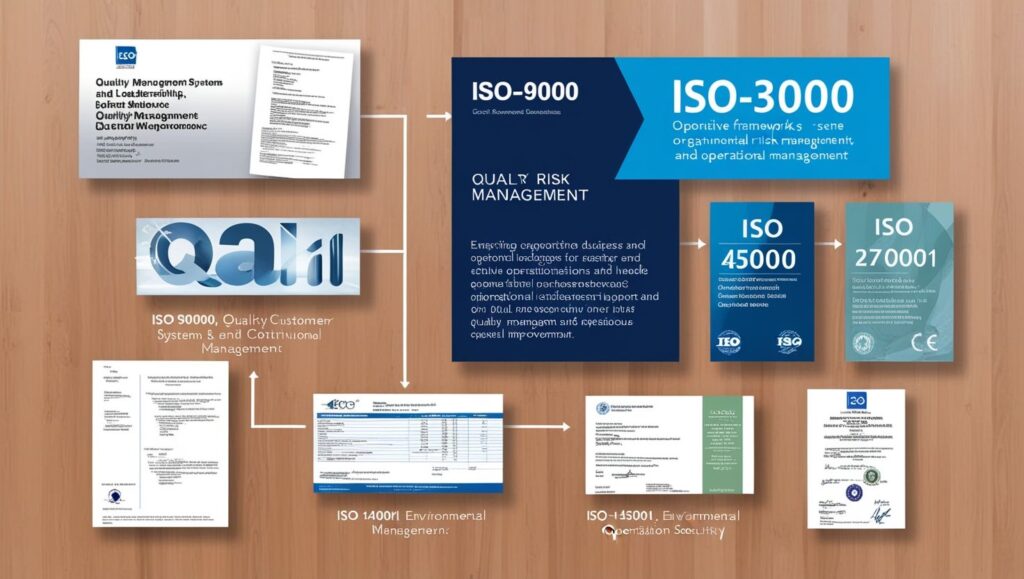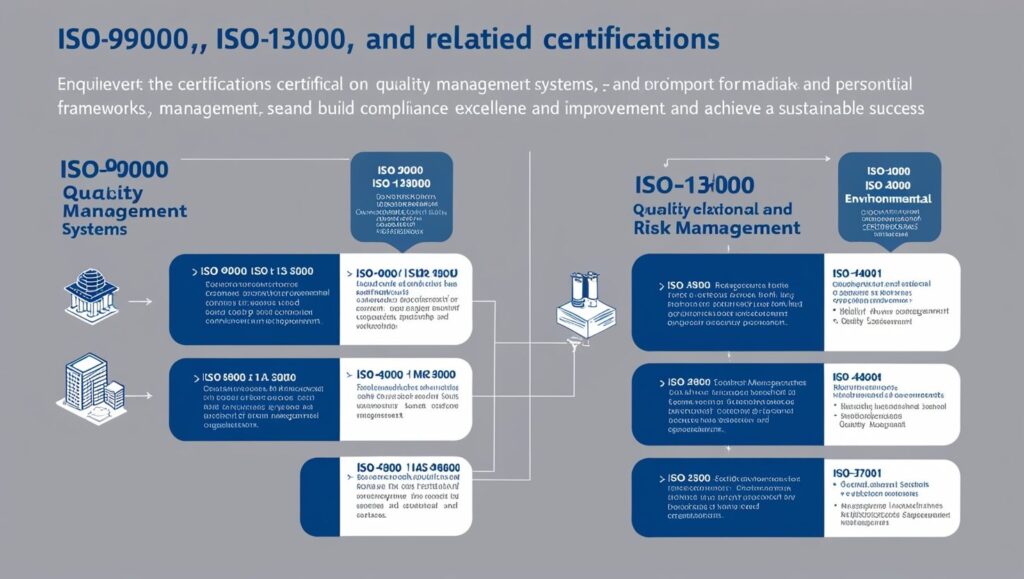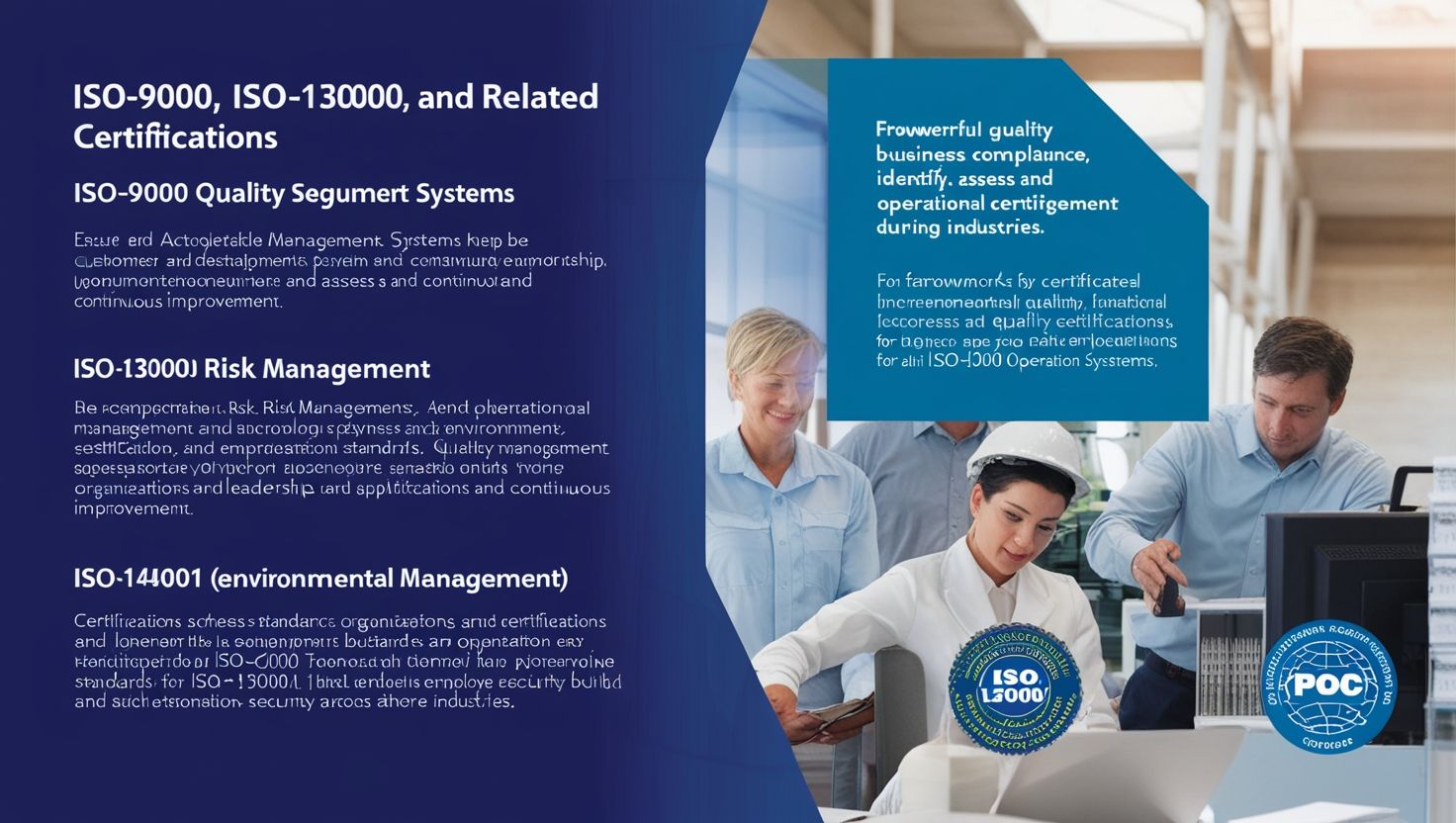ISO-9000, ISO-13000, Certifications for Quality Measurement, Certifications play a crucial role in ensuring consistent quality, efficiency, and reliability across industries. among other certifications, provide globally recognized frameworks for organizations striving to achieve operational excellence. This article delves into these certifications, their principles, significance, and their impact on industries worldwide.
Understanding ISO-9000
The ISO-9000 series, established by the International Organization for Standardization (ISO), outlines standards for quality management systems (QMS). First published in 1987, it serves as the foundation for ISO-9001, the most widely adopted standard in this series.
Key Principles of ISO-9000
ISO-9000 emphasizes several core principles:
- Customer Focus: Organizations must meet customer expectations and aim to exceed them.
- Leadership: Strong leadership ensures alignment of organizational goals with quality objectives.
- Engagement of People: Employees across all levels contribute to achieving quality objectives.
- Process Approach: Efficient management of interrelated processes enhances performance.
- Continuous Improvement: Organizations are encouraged to strive for consistent enhancement.
- Evidence-Based Decision Making: Decisions must rely on data and factual analysis.
- Relationship Management: Building strong relationships with stakeholders boosts organizational success.
Benefits of ISO-9000 Certification
- Improved product and service quality.
- Enhanced customer satisfaction and loyalty.
- Greater operational efficiency and reduced waste.
- Improved credibility and market competitiveness.
ISO-13000: A Focus on Risk Management
ISO-13000 primarily addresses risk management. It provides guidelines for designing and implementing an effective risk management framework within organizations.
Significance of ISO-13000
Risk management is essential for identifying, analyzing, and mitigating uncertainties that could impact organizational objectives. ISO-13000 helps businesses to:
- Build resilience against potential disruptions.
- Enhance decision-making processes through structured risk assessments.
- Comply with legal and regulatory requirements.
- Strengthen stakeholder confidence by demonstrating proactive risk handling.
Key Elements of ISO-13000
- Risk Identification: Pinpointing potential risks affecting operations.
- Risk Analysis and Evaluation: Assessing the likelihood and impact of risks.
- Risk Treatment: Implementing strategies to mitigate or eliminate risks.
- Monitoring and Review: Continuously tracking risks and updating management plans.
Other Noteworthy Certifications
In addition to ISO-9000 and ISO-13000, several other certifications measure and promote quality across different domains.
ISO-14001: Environmental Management
ISO-14001 provides a framework for effective environmental management systems (EMS). It helps organizations reduce their environmental footprint while complying with legal requirements.
Key Benefits:
- Improved resource efficiency and waste reduction.
- Enhanced reputation through sustainable practices.
- Compliance with environmental laws.

ISO-45001: Occupational Health and Safety
ISO-45001 focuses on creating safer workplaces. It assists organizations in preventing work-related injuries and illnesses by providing robust health and safety frameworks.
Key Features:
- Identifying workplace hazards.
- Implementing safety measures and employee training.
- Continuous monitoring of health and safety performance.
ISO-22000: Food Safety Management
Designed for the food industry, ISO-22000 ensures food safety across the supply chain, from farm to fork.
Core Components:
- Hazard analysis and critical control points (HACCP).
- Supply chain traceability and risk mitigation.
- Food safety management policies and objectives.
ISO-27001: Information Security Management
With the rise of cyber threats, ISO-27001 offers guidelines for protecting sensitive information. This standard is crucial for IT and data-dependent industries.
Key Practices:
- Risk management for information security.
- Development of an information security management system (ISMS).
- Regular audits and updates for security protocols.
ISO-50001: Energy Management
Focused on energy efficiency, ISO-50001 helps organizations optimize their energy usage and reduce operational costs.
Benefits:
- Reduction in energy consumption and carbon footprint.
- Compliance with energy regulations.
- Cost savings through efficient energy management.
The Role of Other Quality Certifications
Six Sigma
While not an ISO certification, Six Sigma methodologies are widely used for quality improvement. It focuses on reducing defects and improving processes using data-driven approaches like DMAIC (Define, Measure, Analyze, Improve, Control).
Lean Certification
Lean methodologies aim to eliminate waste, optimize processes, and create value for customers. Lean Certification aligns closely with ISO principles of efficiency and improvement.
CE Marking
Primarily relevant in Europe, the CE marking certifies that products meet EU safety, health, and environmental protection standards.
Good Manufacturing Practices (GMP)
GMP ensures quality production in the pharmaceutical, cosmetics, and food industries. It covers various aspects like sanitation, equipment maintenance, and employee training.
CMMI (Capability Maturity Model Integration)
CMMI certification is widely used in software development and engineering to improve process maturity and product quality.

The Importance of Quality Certifications in a Globalized World
In today’s interconnected economy, certifications ensure that organizations meet global quality benchmarks. They facilitate:
- Trade and Market Access: Certified organizations often find it easier to access international markets.
- Consumer Trust: Certifications build confidence in product and service quality.
- Regulatory Compliance: Adhering to certification standards helps businesses avoid legal issues.
- Innovation and Efficiency: Structured frameworks promote continual improvement.
Challenges in Achieving and Maintaining Certifications
While certifications offer numerous benefits, obtaining them can be challenging.
- Cost: Certification processes can be expensive, particularly for small businesses.
- Time and Resources: Implementing and maintaining compliance require significant effort.
- Continuous Monitoring: Organizations must regularly audit and update practices to retain certification.
Despite these challenges, the long-term benefits of improved quality, credibility, and marketability outweigh the costs.
Conclusion
ISO-9000, ISO-13000, Certifications for Quality Measurement, Certifications such as ISO-9000, ISO-13000, and others provide invaluable frameworks for achieving and maintaining quality across industries. They not only enhance organizational efficiency but also foster trust and loyalty among stakeholders. In an increasingly competitive and globalized marketplace, these certifications are indispensable for organizations committed to excellence.
By adopting these quality standards, businesses can navigate challenges, seize opportunities, and create a sustainable impact in their respective fields.

Aw, this was a really good post. Finding the time and actual effort to
create a great article… but what can I say… I put things off a whole
lot and don’t seem to get nearly anything done.
wyqb7m
Nice post. I be taught something more difficult on completely different blogs everyday. It would at all times be stimulating to learn content material from other writers and apply a little bit one thing from their store. I’d choose to make use of some with the content on my blog whether or not you don’t mind. Natually I’ll offer you a link on your internet blog. Thanks for sharing.
umf402
Thanks for all your efforts that you have put in this. very interesting information.
There are some fascinating time limits in this article but I don’t know if I see all of them middle to heart. There is some validity however I will take hold opinion until I look into it further. Good article , thanks and we wish more! Added to FeedBurner as effectively
I truly appreciate this post. I?¦ve been looking everywhere for this! Thank goodness I found it on Bing. You have made my day! Thank you again
Really Appreciate this update, how can I make is so that I get an update sent in an email when there is a new article?
obviously like your web site however you need to check the spelling on several of your posts. A number of them are rife with spelling issues and I in finding it very bothersome to inform the reality then again I will certainly come back again.
This design is incredible! You certainly know how to keep a reader entertained. Between your wit and your videos, I was almost moved to start my own blog (well, almost…HaHa!) Great job. I really loved what you had to say, and more than that, how you presented it. Too cool!
Hmm is anyone else having problems with the images on this blog loading? I’m trying to find out if its a problem on my end or if it’s the blog. Any responses would be greatly appreciated.
Good blog! I truly love how it is simple on my eyes and the data are well written. I’m wondering how I might be notified whenever a new post has been made. I’ve subscribed to your RSS which must do the trick! Have a great day!
I?¦ve been exploring for a bit for any high-quality articles or weblog posts in this sort of space . Exploring in Yahoo I eventually stumbled upon this web site. Reading this info So i am glad to show that I have an incredibly good uncanny feeling I discovered just what I needed. I such a lot undoubtedly will make certain to don?¦t forget this web site and give it a glance on a relentless basis.
Very nice article, exactly what I was looking for. https://glassiuk.wordpress.com/
This blog is definitely rather handy since I’m at the moment creating an internet floral website – although I am only starting out therefore it’s really fairly small, nothing like this site. Can link to a few of the posts here as they are quite. Thanks much. Zoey Olsen
Very interesting details you have mentioned, regards for putting up. “History is a cyclic poem written by Time upon the memories of man.” by Percy Bysshe Shelley.